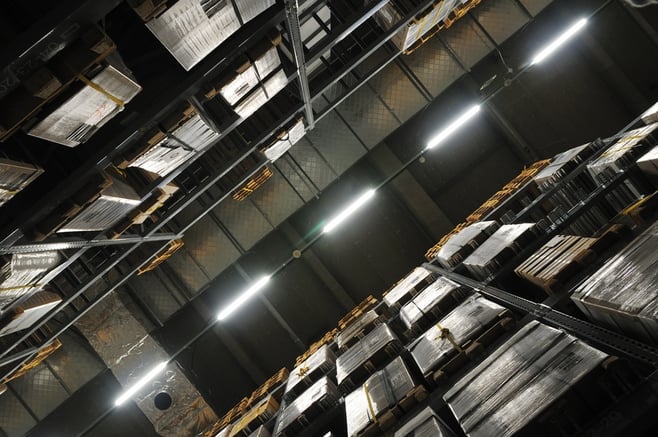
At first glance, warehousing seems pretty simple, right? You produce your product. You store it in your warehouse. And then you ship it to your customer. There’s not much complexity to the warehousing operation.The truth is that far too many industrial companies take this oversimplified, and inaccurate, approach to warehousing. The result is an inefficient warehouse that negatively impacts their cash flow and their bottom line.
If you warehouse your own products or the parts you need to produce your products, it’s critical that you monitor the warehousing process just as you would any other function. You’re probably always looking for ways to maximize efficiency in production, distribution, and supply chain. Warehousing is no different.
Below are a few common mistakes that industrial companies make when it comes to warehousing. They may seem trivial, but over time they can have a corrosive effect on your productivity and profitability.
1. Not doing routine cycle counts or annual inventory counts.
It’s a problem that should never happen. A customer places a large order for warehoused products. Your records indicate that you have enough in stock to fill the order. However, when your team goes to the warehouse to pick the products, they discover that the records are wrong. There isn’t enough product available.
Now you have two problems: producing enough product quickly enough to fill the order and figuring out how your inventory records became so inaccurate.
The solution is to conduct regular cycle counts and at least annual total inventory counts. In the cycle counts, you count a small sample of one group of product to get a gauge on the accuracy of your records. Ideally, the records are accurate. If the sample indicates that there may be an error, though, you can then dive deeper to see how the error occurred.
 Perform cycle counts regularly. The more frequently you do them, the more accurate your inventory records will be. Also, conduct them in the same pattern throughout the warehouse. That way, you’ll always know where you left off and where you need to go next.
Perform cycle counts regularly. The more frequently you do them, the more accurate your inventory records will be. Also, conduct them in the same pattern throughout the warehouse. That way, you’ll always know where you left off and where you need to go next.
In addition to cycle counts, you also want to do a full inventory count once a year. This is when you shut everything down and physically count your entire inventory.
Some companies attempt to continue production or distribution while doing their full inventory. This is usually a mistake. When you have movement in the warehouse, it’s nearly impossible to verify that your count is accurate. That undermines the entire point of doing the count. Shut it down so you can ensure that your count is accurate.
2. Not being aware of your inventory turnover or how that figure directly impacts your cash flow and bottom line.
 If you struggle with cash flow issues, you can draw a direct line between those challenges and the number of times you turn over inventory each year. Inventory turnover is a crucial metric. However, many companies don’t know what their turnover is or they don’t monitor it enough to see the relationship between inventory turns and cash flow.
If you struggle with cash flow issues, you can draw a direct line between those challenges and the number of times you turn over inventory each year. Inventory turnover is a crucial metric. However, many companies don’t know what their turnover is or they don’t monitor it enough to see the relationship between inventory turns and cash flow.
Simply, your inventory turnover is the rate at which you cycle through your inventory over a given period of time. For instance, you may completely cycle through new inventory several times a year. The higher your turnover, the more product you’re pushing out the door, and the more frequently you’re getting paid.
Your inventory turns are like a score for your efficiency. When you know what your turns are, you can look for ways to continuously improve and increase your inventory rate. Over time those improvements will compound, and you’ll see the results in your bottom line.
3. Not cross training employees on a variety of warehousing functions.
Workflow in a warehouse is rarely static. Some days it’s all about stocking product, while other days the priority is pulling parts or product for distribution. There are cycle counts, workflow schedules, reporting, and a wide range of other tasks you must complete to maintain optimal efficiency.
One of the best ways to maintain an efficient warehousing operation is to have a team that’s versatile enough to adjust with demand. Train warehousing team members in all warehouse functions so they’re able quickly react to your facility’s evolving needs.
 To ensure that your warehousing is team is adequately cross trained, put dynamic and passionate leaders into frontline supervisory positions. The supervisor can make or break the quality of your team. You want supervisors who understand the important metrics, like accuracy and inventory turns, and who can keep their team members trained and engaged.
To ensure that your warehousing is team is adequately cross trained, put dynamic and passionate leaders into frontline supervisory positions. The supervisor can make or break the quality of your team. You want supervisors who understand the important metrics, like accuracy and inventory turns, and who can keep their team members trained and engaged.
Cross training also builds teamwork and morale. When you give team members the opportunity to learn new responsibilities, they usually become more engaged and more collaborative. Training shouldn’t stop once a team member is hired. Make it a constant part of your process and make sure warehouse team members are knowledgeable on every warehouse function.
If you haven’t given your warehousing function the attention it deserves, or if you don’t have the internal resources to support a robust warehousing process, consider outsourcing it. You can then leverage your partner’s processes, management skills, and talented labor force.
Warehousing is much more than just putting products or materials on a shelf. It’s a critical function that directly contributes to your bottom line. Don’t let these common mistakes drag down your warehousing accuracy and effectiveness.






Let Us Know What You Thought about this Post.
Put your Comment Below.